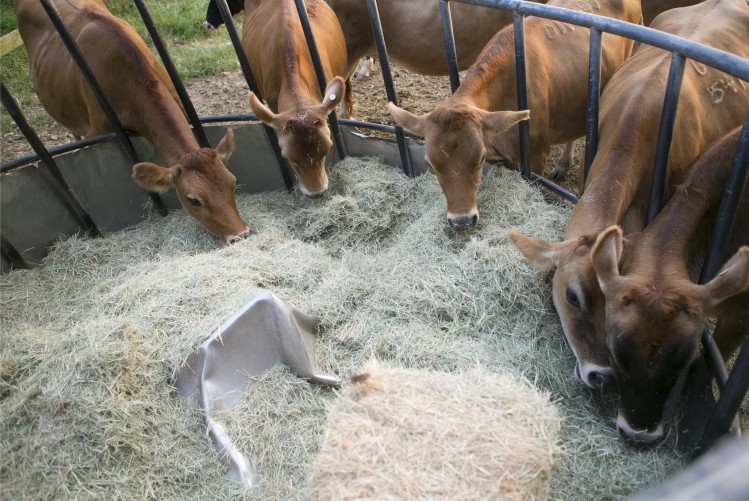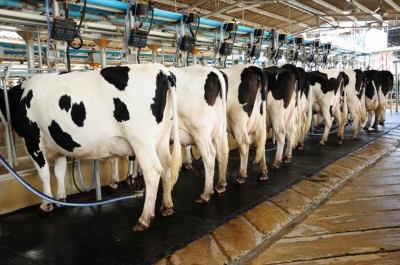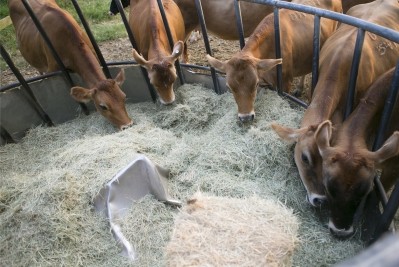Researchers hit on enzyme that stimulates milk production

An international group of researchers based at the University of Florida explored the use of two exogenous fibrolytic enzymes (EFE) to the total mixed rations (TMR) of lactating dairy cows. They also examined how the additives influenced ruminal degradation.
The team published their results in the Journal of Dairy Science.
“The objective of the present experiment was to examine effects of adding 2 EFE (2A or 3A) to a TMR containing bermudagrass haylage, corn silage, and an alfalfa-orchard grass hay mixture, on DMI [dry matter intake], ruminal fermentation, kinetics of ruminal digestion, and performance of lactating dairy cattle,” said the researchers. “We hypothesized that adding either of the EFE to the diet would increase the performance of cows, but EFE 2A would produce a greater response because it increased the NDFD of the dietary forages to a greater extent than EFE 3A in the screening studies.”
The group found that the EFE additives did not alter rumen functioning, pH, ammonia-N or fatty acid concentration, they said. However, the feed supplements had a larger influence on milk production.
“Application of 2A [diet] to the bermudagrass-based TMR increased DM [dry matter] intake and milk production, implying that this EFE could be used to increase the performance of lactating dairy cows fed diets containing up to 10% bermudagrass,” said the researchers.
Why enzymes?
Exogenous fibrolytic enzymes have been tested with forage diets but results have been ambiguous and their mode of action is poorly understood, said the researchers. Supplementing feed with EFE may improve feed efficiency and allow for use of feed ingredients that have a larger amount of fiber than corn, they said.
Some previous studies also have found that the supplement may work better for cattle fed ad libitum and not getting a TMR, said the team.
The enzymes have been used with corn silage and alfalfa, feed ingredients that are less economically sound in warmer regions of the US where perennial warm-season grasses like bermudagrass are more available, they said. But the grasses also have higher fiber content and lower digestibility for dairy cows, which may make them better candidates for enzyme use.
“Arriola et al. (2011) reported that adding an EFE to a corn silage and alfalfa hay-based TMR for dairy cows increased NDF digestibility by 6%, and increased feed efficiency (FCM:DMI) by about 16%,” said the researchers. “However, when the same EFE (Queiroz et al., 2011) and another one (Bernard et al., 2010) were applied to a bermudagrass silage-based TMR, none of the performance measures was increased.”
A series of in vitro experiments with EFE and bermudagrass were completed prior to the in feed trial to maximize the potential for positive results, they said.
Trial details
In the first feeding trial, a group of 66 dairy cows were given one of three diets, said the researchers. The trial feeds included an untreated control (CON), that diet with xylanase plus at 1mL/kg of TMR dry matter (2A) and the control TMR with a three to one mixture of cellulose plus and xylanase plus (3A).
The TMR included 10% Bermuda grass silage, 35% corn silage, 5% alfalfa-orchard grass hay and 50% concentrates, and the enzymes were added twice a day, they said. Diets were fed for a training period and 70-day study.
The commercially available EFE used in the diets had previously been selected after a series of in vitro assays designed to determine which were the most potent and what the best amount to use was, they said.
Milk production was analyzed and recorded daily, said the researchers. Body weight was noted twice daily and body condition scores were done initially and every week of the test.
Feed and ort samples were checked for DM, NDF and ADF, they said. Fecal samples were collected and checked for DM, organic matter (OM), nitrogen (N), neutral detergent fiber (NDF) and acid detergent fiber (ADF), and apparent digestibility of DM, OM, CP, NDF, hemicellulose (HEM) and ADF were also recorded.
Blood samples were taken weekly to measure plasma glucose and blood urea nitrogen (BUN), they said.
The second part of the trial examined ruminal degradability and fermentation from the diets used, said the researchers.
Three cows were fed the diets for 23-day periods, they said. Three days were used to measure the ruminal degradability and for sample taking and one was used to note indices of ruminal fermentation.
Results
The 2A diet produced a greater intake of DM, OM and CP, said the researchers. It also tended to boost yields of fat-corrected milk and milk fat, especially for weeks three, six and seven of the study.
“Greater DMI is beneficial for dairy cows because milk production is limited by intake of digestible energy (Beauchemin and Holtshausen, 2010),” they said.
The 3A feed improved milk yield for weeks six, eight and nine and tended to increase mean milk fat yield:
“This study confirms our hypothesis that 2A and 3A can be used to increase the performance of lactating dairy cows fed diets containing 10% bermudagrass,” said the researchers. “The study also confirms our second hypothesis that 2A would be more effective than 3A at increasing the performance of cows based on its greater efficacy at increasing NDFD in our previous in vitro ruminal digestibility studies.”
For the second part of the study, the EFE was not found to alter the degradation kinetics for DM or ruminal pH, ammonia-N or volatile fatty acid concentration, they said.
Source: Journal of Dairy Science
Title: Improving the performance of dairy cattle with a xylanase-rich exogenous enzyme preparation
DOI: 10.3168/jds.2015-10082
Authors: J. Romero, E. Macias, Z. Ma, R. Martins, C. Staples, K. Beauchemin, A. Adesogan,









